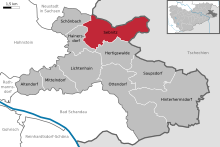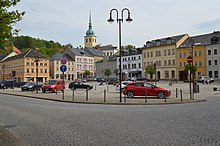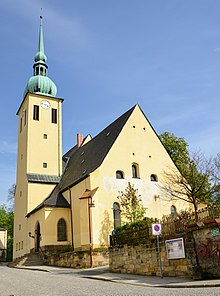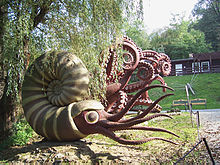Sebnitz
| coat of arms | Germany map | |
|---|---|---|
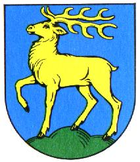
|
Coordinates: 50 ° 58 ' N , 14 ° 17' E |
|
| Basic data | ||
| State : | Saxony | |
| County : | Saxon Switzerland-Eastern Ore Mountains | |
| Height : | 379 m above sea level NHN | |
| Area : | 88.23 km 2 | |
| Residents: | 9461 (Dec 31, 2019) | |
| Population density : | 107 inhabitants per km 2 | |
| Postcodes : | 01851-01855 | |
| Primaries : | 035971, 035974, 035022 | |
| License plate : | PIR, DW, FTL, SEB | |
| Community key : | 14 6 28 360 | |
| LOCODE : | DE SBZ | |
| City structure: | 10 districts | |
City administration address : |
Kirchstrasse 5 01855 Sebnitz |
|
| Website : | ||
| Lord Mayor : | Mike Ruckh ( CDU ) | |
| Location of the city of Sebnitz in the Saxon Switzerland-Eastern Ore Mountains district | ||
Sebnitz is a large district town in the Saxon Switzerland-Eastern Ore Mountains district . It is a state-approved resort in East Saxony on the edge of the Saxon Switzerland National Park . Sebnitz is also called the city of artificial flowers or the city of silk flowers .
geography
The city of Sebnitz is located in the valley of the river Sebnitz and its side valleys between 250 and 460 m above sea level between Saxon Switzerland and the Lusatian mountains . In terms of nature, the urban area is located in the West Lusatian hills and mountains , but borders directly on the Upper Lusatian highlands . Since the natural area of Saxon Switzerland is also very close, the landscape around the city is varied. Sebnitz's local mountain is the Tanzplan (Tanečnice) mountain , which is already in the Czech Republic . East of Sebnitz is Dolní Poustevna (Niedereinsiedel) in the Schluckenau tip .
The districts are Sebnitz, Altendorf , Lichtenhain , Mittelndorf , Ottendorf , Saupsdorf (all incorporated on October 1, 2012 as the Kirnitzschtal municipality founded on March 1, 1994 ), Schönbach (incorporated on December 1, 1935), Hofhainersdorf (incorporated on January 1, 1920 ), Amtshainersdorf (July 1, 1950), Hertigswalde (July 1, 1950) and Hinterhermsdorf (October 1, 1998 ). The district Hinterhermsdorf lies above the Kirnitzschtal about five kilometers southeast of the main town.
history
founding
Sebnitz is a foundation of German farmers from Franconia . The name is probably derived from Sebenica (= Finkenwaldbach ). The oldest documentary evidence for the brook was in the Upper Lusatian border document from 1223/1241, in which the ownership of the Kingdom of Bohemia and the Diocese of Meißen were recorded. Between the end of the 12th century and the beginning of the 13th century, the square market square of the settlement was built as the center of the market settlement.
Development into an artificial flower city
The town hall, built in the middle of the market in 1714/15, was destroyed by fire in 1854. The shed-like house next to it, the meat banks (butchers' stalls) were destroyed by floods in 1804. Sebnitz was an agricultural town, d. H. Crafts, trade and agriculture were the livelihoods of the citizens. Linen weaving was the most important of the crafts. Since the 16th century, weavers have mostly worked on behalf of publishers (billing agents). They exported to many countries around the world. With the decline of hand-weaving, caused in particular by the industrialization of this branch of industry in England, the production of artificial flowers gained in importance due to the influence of German-Bohemian flower makers. In the middle of the 19th century the city had 4,000 inhabitants and 375 houses, in 1881 there were 6,354 inhabitants and in 1900 there were 8,648 inhabitants. On September 15, 1854, a major fire destroyed the entire town center and the traditional medieval townscape. A total of 72 houses, 42 barns and back buildings, the town hall and the school fell victim to the flames.
Sebnitzer Christmas tree decorations
From around 1870 to around 1910, Sebnitz was a center for the manufacture of Christmas tree decorations . Unlike in centers like Gablonz or Lauscha , the Sebnitz jewelry was made at home . In this case, soldered together iron wire scaffolding or shapes made of cardboard or cotton with materials such as perforated films were (punched Sequin , sheets) radicals, chenille , tinfoil , Plätt , tinsel , Kantillen (Bouillon wire, Leone wires), artificial flowers , Gablonzer hollow glass rods, glass beads, cardboard or scraps (cachets ) decorated. He could not hold his own against the industrially manufactured Christmas decorations, which is why production finally ceased.
Center of German artificial flower production
Sebnitz became the center of German artificial flower production around 1900. At that time there were over 200 small and large flower factories with permanent workers and thousands of home workers. On March 17, 1894, local researcher Alfred Meiche suggested setting up a local history museum in the local newspaper Grenzblatt . In the spring of 1908, the trade association took on the matter and the first exhibits were housed in the city school at the church. In 1909 an exhibition was set up and on May 23, 1909 the Sebnitz City Museum was opened, which was given new premises in 1930.

End of the Second World War
Mayor Steudner was removed from office on May 11, 1945 and the doctor Muder was appointed as the new mayor. On September 30, 1945, Sebnitz temporarily had 14,500 inhabitants due to the reception of many expellees and refugees. On November 12, 1945 Karl Seewald became the new mayor. On June 1, 1946, Sebnitz had 13,203 residents and 1,304 houses and 183 businesses. On February 16, 1948, 1847 children in 47 classes with 35 teachers attended primary school. On July 12, 1948, the Abitur was taken for the first time at the newly founded college for business and administration . During the GDR times, VEB Kunstblume Sebnitz was one of the largest employers in the region. In addition, VEB Hebezeugwerk Sebnitz was located in the city, which in 1950 took over the site of the former Sebnitz paper factory and manufactured cranes there.
Administrative division in the GDR
The postal code of the city of Sebnitz in the GDR was the number 8360. The municipality number of the city was 121530 - Dresden district - Sebnitz district - The size class (GK) of the city was 14.
After the turn
However, after the reunification of Germany and the introduction of the market economy in the new federal states, many industrial companies had to close. Today there is only a small amount of flowers , especially in show workshops , as the regional expression for the production of artificial flowers at home is called. In January 2002, Hinterhermsdorf was awarded the gold medal in the 20th national competition at the Green Week in Berlin. Our village should be more beautiful - our village has a future . In 2003, Sebnitz hosted the Saxon Day . In August 2008, the former border clearance systems to the neighboring Dolní Poustevna / Niedereinsiedel were removed.
Changes in the organizational structure since 1952
In 1952, Sebnitz became the district town of the Sebnitz district . Sebnitz lost this status in the course of a regional reform in 1994 . In 1995 Sebnitz became a major district town . The neighboring community of Kirnitzschtal was incorporated into Sebnitz on October 1, 2012. As a result of the incorporation, the Hinterhermsdorf exclave , which was incorporated on October 1, 1998, got a direct connection to the urban area again.
Media scandal in November 2000
In November 2000, the city of Sebnitz hit the headlines nationwide. On the basis of testimonies, which an expert opinion by the criminalist Christian Pfeiffer classified as credible, many media reported that the six-year-old Joseph Kantelberg-Abdullah was drowned on June 13, 1997 by racist German youths in an outdoor pool in Sebnitz and hundreds of guests did not intervene. The Dresden Public Prosecutor's Office then issued arrest warrants for three suspects. The actual cause of death of the boy was a heart attack while swimming, followed by drowning, triggered by a congenital heart defect , which was concealed by the mother during the investigation , as Der Spiegel reported in January 2001. The events surrounding the boy's death led to months of intensive nationwide reporting, during which the then Chancellor Gerhard Schröder received the boy's mother.
The film director Volker Schlöndorff was also interested in the supposed material. Shortly before the real cause of death was discovered, the city council passed a 66-point catalog (How to continue in Sebnitz?) , In which the city summarized demands totaling 34 million DM . In addition to preventive youth projects, the document called for the state government to renovate the railway line to Bad Schandau (20 million DM), a weather station (20,000 DM) and press trips for editors-in-chief to dialogue with young people from Sebnitz (50,000 DM).
Flood 2010
On August 6, 2010, heavy rains began over the area of Sebnitz, whereupon the city's river of the same name rose sharply, as a result of which the market flooded and made it almost inaccessible. In addition, several cellars were full and streets were flooded. Within days the water receded and showed the extent of the damage. Most of the market had been badly damaged. The resumption of classes at Sebnitz schools was originally planned for August 9th, but had to be postponed to August 11th due to the inaccessibility of the market and the way to school.
775th anniversary of the city of Sebnitz
For the 775th anniversary of the city of Sebnitz, a large city festival took place from June 17 to 19, 2016. The highlights were a historical parade with many depictions of the settlement history, the development of the city and its districts. At the end of the three-day celebrations, a 50-meter high-mast motorcycle show by the Wisdom siblings took place on the historic market square, followed by a fireworks display.
116th German Hiking Day - Fresh up!
The 116th German Hiking Day took place in Sebnitz from June 24th to June 27th, 2016 . Program highlights during these days were many cultural events on the town's market square, with a parade of 58 hiking clubs. It is customary for the pennant of the German Hiking Association to be carried from town to town like the “ Olympic flame ”. In 2017, a hiking group from Sebnitz will carry the pennant on foot to Eisenach , the next host city.
During his visit on June 26, 2016, Federal President Joachim Gauck was received in Sebnitz with aggressive chants such as "Get out of here" and "Traitor to the people". The incident made headlines nationwide. Mayor Mike Ruckh said after the visit that he and the Federal President had prepared for such incidents. About "90 percent of the mob" did not come from the city. The overwhelming majority of Sebnitz citizens and visitors welcomed Federal President Gauck, who attended the 116th German Hiking Days as patron, with warm joy and applause.
150th anniversary of the Sebnitz fire brigade
In Sebnitz from July 29th to July 1st, 2018 the festival weekend “150th anniversary of the Sebnitz fire brigade” was celebrated. A large number of old, historical fire departments presented the technical development history of the fire departments in the district of Sebnitz and Saxony. Modern fire fighting vehicles rounded off the historical parade. The parade was set up on Walther-Wolff-Strasse, leading across the market to Schillerstrasse.
Cycle races - around Sebnitz
The bike race around Sebnitz has been taking place in Sebnitz since 1954. In 2018 it will be the 43rd edition and currently (2018) it has the status of a Bundesliga bike. In 2018, 22-year-old Marcel Franz from the Herrmann cycling team won the men's elite class with a time of 2:52:18 hours. Jonathan Dinkler from the P&S team Thuringia came in second.
185 years of Sebnitz artificial flower
The Sebnitz artificial flower has influenced the image of the city of Sebnitz like no other branch of industry since 1834. Magnificent town houses still characterize the cityscape of the flower town of Sebnitz. On April 7, 2019, the city of Sebnitz celebrated the 185th anniversary of the Sebnitz artificial flower. Mayor Ruckh gave a speech in the town hall of Sebnitz, at which he announced that an application had been made to declare the Sebnitz artificial flower a UNESCO World Heritage Site .
Development of the population
|
|
|
(1444–1871: Meiche 1927 / 1892–1918: Schober 1988 / 1990–2004: State Statistical Office of the Free State of Saxony)
politics
City council
Since the municipal council election on May 26, 2019 , the 18 seats of the city council have been distributed among the individual parties and groups as follows:
| Party / group | Seats |
| CDU | 6th |
| AfD | 4th |
| The left | 1 |
| GREEN | 1 |
| Participation in city and country (MSL) | 3 |
| Future of Sebnitz (ZS) | 2 |
| We For Here - The Home List (WFH) | 1 |
Sister cities and partnerships
Sebnitz maintains international relations with Bruntál (Freudenthal) in the Czech Republic and Cascina in Italy as well as with the Rhineland-Palatinate town of Montabaur . In addition, there are close partnerships between the ev.-luth. Parish of Sebnitz and Hinterhermsdorf-Saupsdorf and the Protestant parish of Weißenburg in Bavaria.
coat of arms
Blazon : The coat of arms of the large district town of Sebnitz shows a golden stag in blue, on a green three-mountain, walking to the right .
Chain of office of the Lord Mayor
On the occasion of the 775th anniversary of the city of Sebnitz, 21 donors created a chain of office for special occasions of the Lord Mayor - such as the visit of the Federal President on the 116th German Hiking Day . It consists of gold-plated silver with 17 barrel-shaped, arched chain links and two lined up, round medals from the district of Saxon Switzerland-Eastern Ore Mountains and the Free State of Saxony. The design is kept simple; the round medal pendant shows the coat of arms of Sebnitz. The chain of office is handed over to the next mayor and remains the property of the City of Sebnitz. It was created by master goldsmith Doren Biedermann.
Culture and sights
- see also: List of cultural monuments in Sebnitz
Memorials
- War memorial on the green area between Kirchstrasse and Pfargasse in Sebnitz for the fallen of the First World War .
- Commemorative plaque on the Hertigswalde 120 house for Carl Bantzer (1857–1941), who taught at the Dresden Art Academy and in 1899 did open-air painting with students in Hertigswalde and the surrounding area.
- Memorial plaque on the house at Albert-Kunze-Weg 9 to Albert Kunze (1877–1949), painter, lithographer and advertising artist, who lived in this house until his death.
- Commemorative plaque on house no. 49 in the Hertigswalde district of the 600 concentration camp prisoners on a death march from a satellite camp of Sachsenhausen concentration camp , who were driven through the village by SS men in April 1945 and some of them were mistreated to death
- Cenotaph from 1950 in Bahnhofstrasse for the victims of fascism
- Memorial plaque at the Schandauer Straße 26 elementary school in memory of the death march of concentration camp prisoners from the Schwarzheide satellite camp of Sachsenhausen concentration camp, who were driven through the village in April 1945
- City orientation boards from 1997 on the houses of Jewish residents who fell victim to the Shoah during the Nazi regime : Lange Straße 1, Lange Straße 11 and Markt 15
- Memorial stone in the area of the former kindergarten Burggässchen 10 , which bore his name in GDR times, in memory of the resistance fighter Arthur Hartmann, who died in 1940 as a result of imprisonment
- Memorial plaque on the house where he was born in Martin-May-Straße 19 in memory of the communist resistance fighter Martin May , who died in a Berlin satellite camp of Sachsenhausen concentration camp in 1944
- Memorial plaque on Dr.-Petzold-Straße 12 in memory of the communist Spain fighter Alfred Möbius , who died in 1945. The plaque was removed after 1990 and is kept by the residents
- A memorial stone in the cemetery of the Saupsdorf district commemorates 14 concentration camp prisoners , mainly Czechs and Jews, who were killed on a death march from the Schwarzheide concentration camp subcamp , who were murdered by SS men in the spring of 1945.
- A memorial stone in front of the municipal administration of the Saupsdorf district also commemorates these prisoners.
- A memorial plaque on the murder site in Hinterhermsdorfer Straße in the Saupsdorf district commemorates seven murdered people, two of whom are unknown by name
- A plaque on the Gnauckmühle commemorates five named inmates and an unknown Frenchman.
- A memorial plaque on the baptismal font from 1637 in the Sebnitzer Wald reminds of the severe hardship in the Thirty Years' War.
- A memorial plaque on the Peststein not far from the Waldstadion reminds of Maria Wunderlich, who lived here in a hut built for her and is said to have died.
Buildings
The Protestant Church of Peter and Paul is the city's oldest monument. The choir is from the 15th century, the nave and interior from the 17th century. The almost square nave from 1619 with a four-sided circumferential gallery and the pulpit on the southern long side is built as a typically Protestant transverse church and furnished in the Renaissance style.
The Catholic Church Exaltation of the Cross was built in the late 19th century in the neo-Gothic style.
The townscape is shaped by town houses and production buildings from the Wilhelminian era that were built after the town fire in 1854. The structural ensemble of the market square, which was rebuilt in the late classicist style, with the replica of the Saxon post office column is a listed building. The originally numerous surrounding and half-timbered houses are only preserved in the outskirts of the city center.
The viaduct built in the course of the Sebnitztalbahn (1874/75) was the first in Germany to be built in a curve (radius 224 meters) and on a slope (slope 1:50). It is 150 meters long and 21 meters high. Its original ten stone arches were replaced by nine concrete pillars during a general renovation at the end of the 1980s.
Theater and orchestra
In Sebnitz there is the amateur theater Theater Libre . Well-known orchestras are the Bergsteigerchor Sebnitz, the youth wind orchestra Sebnitz eV the Sachsenländer Blasmusikanten e. V.
Museums
The artificial flower and local history museum “Prof. Alfred Meiche ” in a town house built in 1731
the Africa House
the House of German Artificial Flowers Sebnitz
The model railway museum in the factory of TILLIG Modellbahnen GmbH & Co. KG
Religions
- Wat Mahatatu, Kreuzstrasse 12 - Buddhist Thai temple. In spring 2015, the Thai Buddhist temple was inaugurated by the Thai community with the support of the Royal Thai Embassy Berlin.
- Evangelical parish
- Catholic parish
Sports
Important sports clubs in Sebnitz include the handball club Sachsen Neustadt-Sebnitz, the BSV 68 (BürgerSportVerein 68), which is divided into the sections football, tennis, table tennis and bike ball, the BSG Sebnitz with boxing, fistball and chess and the sports club Sebnitz boundary angle.
Sports facilities
Since the 1970s there has been a model flying center at the entrance to Sebnitz (coming from Neustadt), where the International Saxon Switzerland Cup for model pilots takes place every year in June. There is also the Sparkassen -Waldstadion of the BSV 68 Sebnitz with a capacity of about 3000 people and an artificial turf and a lawn playing field. The city has been home to the Soli Vital sports and leisure center since 1996 .
Regular events
The concert series in the Evangelical Lutheran City Church in Sebnitz, the Flower and Music Festival, the Weifberg Festival in Hinterhermsdorf and the Zwinger Plaza Open Air Festival take place regularly. In addition, Sebnitz has its own festival, the so-called "Wonnemond", which takes place every year in May.
Sights and nature
Places worth seeing are the Sebnitz prehistoric park with 400 sculptures of prehistoric mammals and small creatures, the model railway museum of the Tillig company, the Westernvillage and the 36.9 meter high wooden observation tower on the Weifberg .
One of the natural treasures is the Kirnitzschklamm near Hinterhermsdorf with the boat trip on the upper lock . The Heilige Hallen nature reserve is located on the northern slope of Tanečnice (German: Tanzplan ), which is almost 600 meters high in the neighboring Czech Republic .
Remarkable
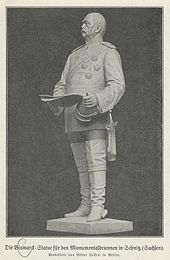
Sebnitz is the largest state-recognized resort (title since 1997) in Saxony . The world's largest silk rose with a height of 3.7 m was produced in the city. Its flower is 1.5 m in diameter and weighs 10 kg. A folk art that is unique in the world, the Sebnitz shadow play , was also created here at the beginning of the 19th century .
In 2002 the district of Hinterhermsdorf was awarded the title Most Beautiful Place in Germany and came second in a European comparison.
marketing and advertisement

A public bus was pasted as an advertising space for Sebnitz - "City of Artificial Flowers". He travels on line 261 to the state capital Dresden .
Economy and Infrastructure
traffic
As one of the first important transport routes for Sebnitz, the Sebnitz Valley Railway was opened from Bad Schandau via the Sebnitz (Sachs) station to Bautzen . In 1905, the Rumburk – Šluknov – Dolní Poustevna – Sebnitz line followed by the Bohemian Northern Railway . Their operation was stopped after the war ended in 1945 between Sebnitz and Dolní Poustevna . After the 600 meter long connection had been rebuilt, passenger traffic on the U28 line (Děčín - Bad Schandau - Sebnitz - Rumburk) was officially resumed on July 5, 2014. The SB 71 railway line from Neustadt in Saxony to Sebnitz now runs every two hours.
Sebnitz is connected to the state capital Dresden every hour during the week by bus route 261 . On weekends and public holidays, the connection takes place every two hours.
Since 2003 the regional traffic Saxon Switzerland-Eastern Ore Mountains (formerly OVPS ) has been operating a historic bus, the Rose von Sebnitz, in addition to regular public transport .
Since 1995 there is a road border crossing to Dolní Poustevna . With the opening of the Autobahn 17 from Dresden to Prague, Sebnitz got a better connection to the expressway network in Germany.
Established businesses
Larger companies and companies based in the city are Robert Bosch Power Tools GmbH Sebnitz with around 450 employees, Tillig Modellbahnen with around 180 employees, Sebnitzer Fensterbau GmbH with around 110 employees and WEA Wärme- und Energieanlagenbau GmbH with around 80 employees.
The Asklepios Sächsische Schweiz Klinik is a regular provider with two supraregional competence centers, the breast and the abdominal center. There has been a hospital in Sebnitz since 1868. The new building, inaugurated in 1996, was the first completely new building of a hospital in Saxony after 1989; privatization took place in 1999.
Educational institutions
There are two primary schools in Sebnitz, one on Schandauer Strasse and one on Rosenstrasse. In addition, the Goethe-Gymnasium Sebnitz and the high school 'Am Knöchel' are located in Sebnitz.
Personalities
Honorary citizen
- 1866 Vice Mayor Johann August Herrmann
- 1876 lawyer Helmut Geyer
- 1896 Ernst Friedrich Louis Oehmischen
- 1888 master bookbinder Emil August Schubert
- 1901 Mayor Emil Otto Blume
- 1904 Medical Councilor Oskar Theodor Petzold
- 1946 local history researcher Alfred Meiche
- 1979 anti-fascist Hugo Knobloch
- 2017 Manfred Schober, head of the Sebnitz Local History Museum for many years
sons and daughters of the town
- Johann Sigismund von Glaubitz (1764–1838), Prussian major general
- Ilse Ohnesorge (1866–1937), native painter
- Alfred Meiche (1870–1947), historian, folklorist and linguist
- Willy Berger (1888–1976), museologist and local researcher
- Alfred Zirnstein (1899–?), Politician (SPD / DBD)
- Camillo Hölzel (1908–1974), political activist (KPD)
- Siegfried Berger (1918–2002), engineer and social democratic resistance fighter against the GDR dictatorship
- Eberhard Steger (1925–2004), chemist
- Rosemarie Herzog-Götze (1926–2011), actress
- Harald Karas (1927–2015), journalist, news anchor and presenter, born in Ottendorf
- Burkhard Stephan (* 1932), ornithologist
- Winfried Wagner (1937–2018), actor
- Jürgen Thomas (* 1956), ski jumper and ski jumping official
- Silvia Hindorff (* 1961), gymnast
- Reni Dammrich (* 1962), writer
- Heiko Hunger (* 1964), ski jumper and Nordic combined athlete
- Ron Kubsch (* 1965), theologian, missionary and author
- Uwe Prenzel (* 1966), Nordic combined athlete
- Uwe Leichsenring (1967-2006), politician (NPD)
- Raik Dittrich (* 1968), biathlete
- Carsten Heymann (* 1972), biathlete
- Martin Hauswald (* 1982), soccer player
- Tina Grassow (* 1988), short tracker
literature
- Herbert Bergmann (Ed.): What was when in Sebnitz? Timeline and collection of facts on the chronicle of the city of Sebnitz from the settlement up to 2003. Sebnitz 2004 (since then annual additions).
- Wilhelm Leberecht Götzinger : History and description of the Chursächsischen Amt Hohnstein with Lohmen, in particular the city of Sebniz, which belongs to this office. Freiberg 1786 (Reprint Sebnitz 1987) ( digitized ).
- Rainer B. Jogschies: Emotainment. Journalism at a crossroads. The Sebnitz case and the consequences. (= Journalism, Vol. 1 ) Lit Verlag , Münster, Hamburg, London 2001, ISBN 3-8258-5450-7 .
- Between Sebnitz, Hinterhermsdorf and the Zschirnsteinen (= values of the German homeland . Volume 2). 1st edition. Akademie Verlag, Berlin 1959.
- Alfred Meiche : The hallway picture of Sebnitz. Crimmitschau 1925.
- Alfred Meiche : Historical-topographical description of the Pirna administration. Dresden 1927. ( Digitized version ( memento from July 26, 2011 in the Internet Archive ))
- Alfred Meiche : Sebnitzer fire chronicle . Sebnitz 1894 ( digitized version )
- Ms. Unesorge: Name, age and origin of the city of Sebnitz. In: New Archive for Saxon History. 7, pp. 118-130 (1886).
- Manfred Schober: Collection of facts on the history of Sebnitz in the years 1891–1918. In: Heimatmuseum Sebnitz (Hrsg.): The city and the district of Sebnitz in the past and present . Contributions to local history issue 5, Sebnitz 1988, pp. 10-27.
- Manfred Schober: The Sebnitzer artificial flower - the history of a craft under the sign of fashion. Dresden / Basel 1994.
- Manfred Schober: From the history of a Saxon town on the border between Elbe Sandstone and Upper Lusatian Bergland. Berg- & Naturverlag Rölke, Dresden 2003.
- Bernd Strunz among others: Hertigswalde. From Hertewiggisswalde to the district of Sebnitz 1446–2001. Sebnitz 2001
- Richard Steche : Sebnitz. In: Descriptive representation of the older architectural and art monuments of the Kingdom of Saxony. 1. Booklet: Official Authority Pirna . CC Meinhold, Dresden 1882, p. 81.
Web links
- Official website
- Sebnitz in the Digital Historical Directory of Saxony
- Literature about Sebnitz in the Saxon Bibliography
Individual evidence
- ↑ Population of the Free State of Saxony by municipalities on December 31, 2019 ( help on this ).
- ↑ Cf. Alfred Dünnenberger-Hager: O you happy, o you blessed, gracious Christmas season. Self-published, Baar 2015, ISBN 978-3-03808-008-4 , pp. 365–373; Wolfram Metzger, Jutta Tremmel-Endres: trees shining, trees dazzling ... historical Christmas tree decorations. With texts by Hinrich Behning and Helmuth Thoma. Info, Karlsruhe 1996, ISBN 3-88190-209-0 (catalog for the exhibition of the Badisches Landesmuseum 1996/97), pp. 100-105.
- ↑ Local Lexicon of the German Democratic Republic - page 286 - State Publishing House of the German Democratic Republic, Berlin 1986. 1st edition VLN 610.DDR.LSV 9897 - State Printing House of the German Democratic Republic
- ↑ Manfred Schober: Sebnitz. From the history of a Saxon town on the border between Elbe Sandstone and Upper Lusatian Bergland. Berg- & Naturverlag Rölke, Dresden 2003, pp. 9–18.
- ↑ MDR Figaro: Sebnitz, a city under suspicion
- ^ Swimming accident turns out to be racist murder In: Die Tageszeitung , October 24, 2000, accessed on November 12, 2017.
- ↑ Sebnitz: Joseph died of heart failure. In: Der Spiegel , January 24, 2001.
- ↑ A media-critical case analysis of the reporting criticized the technical errors of the journalists and the character of the campaign. See: Rainer Jogschies: Emotainment. Journalism at a crossroads. The Sebnitz case and the consequences. Lit Verlag, 2001.
- ↑ Ullrich Fichtner: A sudden infant death. In: Die Zeit , 49/2000.
- ↑ Sven Röbel, Andreas Wassermann: Who I want . In: Der Spiegel . No. 6 , 2001, p. 73 ( Online - Feb. 5, 2001 ).
- ^ Sächsische Zeitung - Report on the city festival of the silk flower city Sebnitz - 775 years / from June 15, 2016
- ^ Official Journal of the large district town of Sebnitz - New Border Gazette . Volume 27, number 25, June 24, 2016
- ^ Sächsische Zeitung / Sächsische Schweiz / Pirna and Sebnitz , issue 25. – 26. June 2016, p. 15.
- ↑ Saxony: Gauck in Sebnitz insulted and insulted at Spiegel Online, accessed on June 26, 2016
- ^ Gauck insulted as a traitor to Zeit Online, accessed on June 26, 2016
- ↑ Federal President Gauck massively verbally attacked in Saxony at tagesspiegel.de, accessed on June 26, 2016
- Jump up ↑ Federal President in Sebnitz. (No longer available online.) In: mdr.de. Archived from the original on June 26, 2016 ; Retrieved June 26, 2016 . Info: The archive link was inserted automatically and has not yet been checked. Please check the original and archive link according to the instructions and then remove this notice.
- ↑ Uwe Jahn: Who is behind the verbal attacks. (No longer available online.) In: mdr.de. Archived from the original on July 28, 2016 ; accessed on July 28, 2016 . Info: The archive link was inserted automatically and has not yet been checked. Please check the original and archive link according to the instructions and then remove this notice.
- ↑ Commentary by Stanislaw Tillich - Saxony's Prime Minister / Link to mdr.de/nachrichten/politik/regional/grund- gauck-sebnitz- ( Memento of the original from June 28, 2016 in the Internet Archive ) Info: The archive link was inserted automatically and has not yet been checked . Please check the original and archive link according to the instructions and then remove this notice.
- ^ Official Journal of the large district town of Sebnitz - 29th year - number 26 - page 10 - fire brigade
- ^ Event program - 43rd Volksbank Classics road bike race - Rad-Bundesliga 2018 - Sebnitzer RV 1897 e. V.
- ↑ Sächsische Zeitung - September 10, 2018 (Sebnitz edition - page 13) - "Welcome to the cycling Bundesliga"
- ↑ Sächsische Zeitung - Local Sports - September 13, 2018 (Sebnitz edition - page 10) - "Out and about in a hurry"
- ↑ Official Gazette of the large district town of Sebnitz - Neues Grenzblatt - Volume 30, Number 13 - Page 2 -
- ↑ State Statistical Office of the Free State of Saxony, election results for local elections 2019: Sebnitz
- ↑ Picture with description of the mayor's chain of office in: City of Sebnitz receives a valuable gift for the 775th anniversary of the city . In: Official Gazette of the large district town of Sebnitz - New Border Gazette . Volume 27, issue 25 from June 24, 2016.
- ^ A piece of jewelery for the 775th birthday . In: Sächsische Zeitung , Sebnitz / Neustadt / Stolpen issue of June 16, 2016.
- ↑ Image at Wikimedia Commons
- ^ Website of the parish see [1] , last accessed on March 29, 2019
- ^ Homepage Theater Libre / accessed June 20, 2016
- ↑ Anja Weber: Get in and close the doors. Message on sz-online.de on July 7, 2014.
- ↑ Even more power at Bosch , Sächsische Zeitung (Pirna edition) from July 25, 2014
- ↑ Brochure 750 Years of Sebnitz 1991
- ↑ Article “Der neue Ehrenbürger”, Sächsische Zeitung of January 4, 2017





